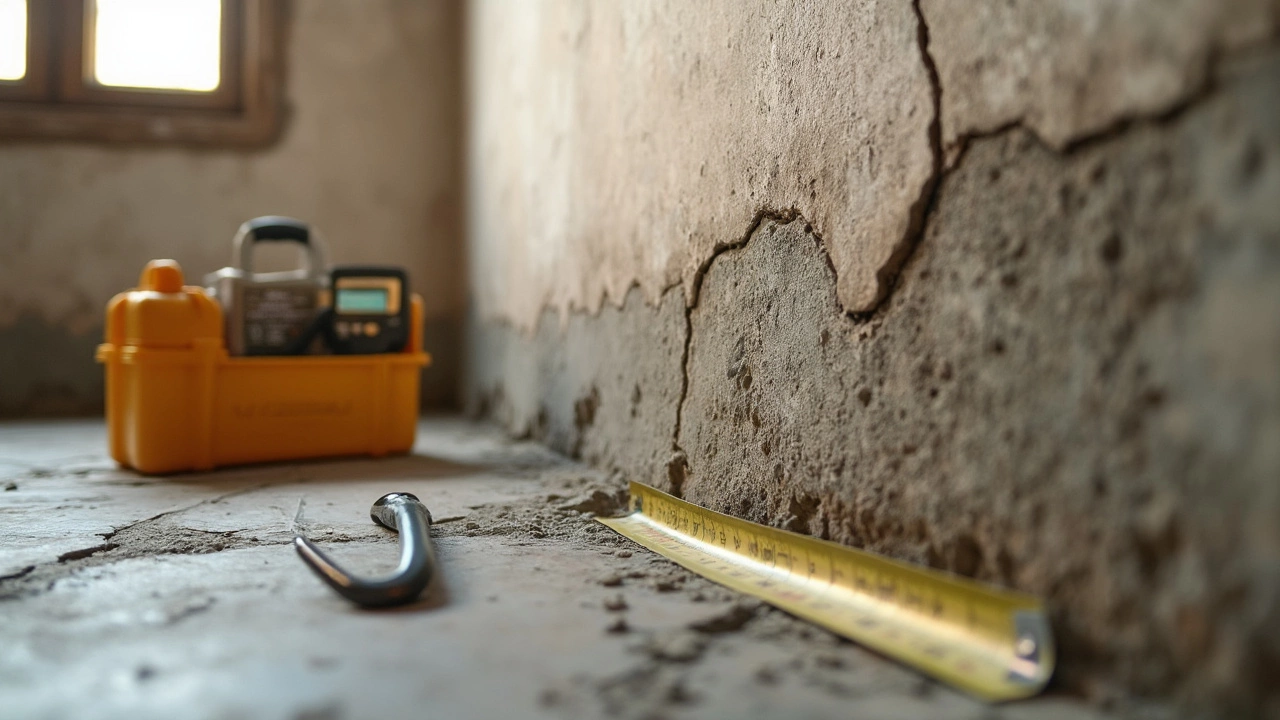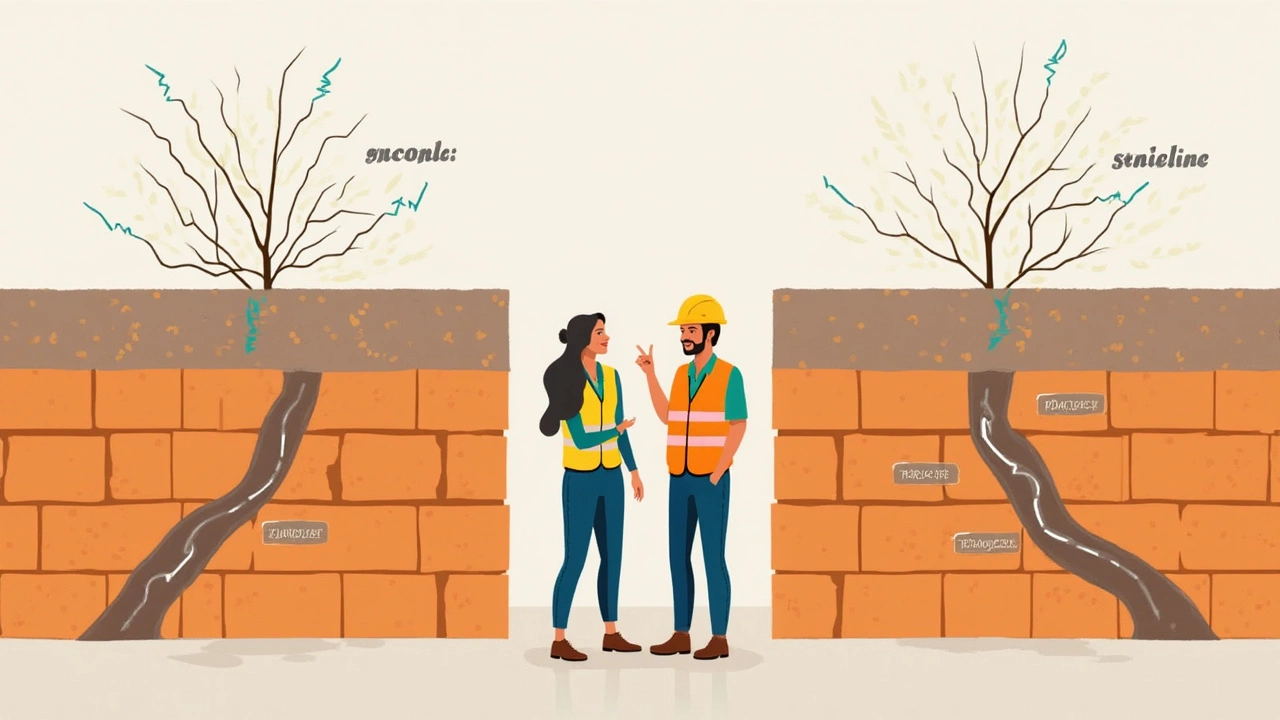You spot a crack in your foundation—cue the panic. Is it harmless or a money pit waiting to happen? Not every foundation crack means disaster, but size definitely matters.
Here’s the quick truth: cracks less than 1/8 inch wide (about the thickness of two credit cards stacked) are usually nothing to freak out about. These small cracks happen as concrete shrinks and settles over time. Keep an eye on them, but you don’t need to rush out and spend a pile of cash.
But if you see a crack wider than 1/4 inch? Now, you’re looking at what most pros consider a red flag. These bigger cracks might mean your foundation is shifting for real, and that’s when you could be dealing with water getting in, sticking doors, or even bowed basement walls. Even hairline cracks can be a problem if they’re growing or showing other suspicious signs.
- Crack Size: The Magic Number
- Types of Foundation Cracks
- Warning Signs Beyond Size
- What Causes Foundation Cracks?
- When to DIY and When to Call a Pro
Crack Size: The Magic Number
So, how wide is too wide when it comes to a foundation crack? It turns out there’s a magic number, and it isn’t pulled from thin air. Most structural engineers and home inspectors agree: a crack up to 1/8 inch (about 3 millimeters) usually isn’t a sign of major trouble, but anything 1/4 inch (6 millimeters) or bigger could spell real issues for your home.
If you don’t have a ruler handy, try this: two stacked credit cards are about 1/8 inch thick. If the crack swallows those, it’s time to watch it closely. If the gap is big enough to slide a pencil in with room to spare, this isn’t just an age line—it may be a warning sign that your foundation’s under stress.
According to the International Association of Certified Home Inspectors, "Vertical cracks less than 1/8 inch wide are generally considered shrinkage cracks and not a structural concern. Horizontal cracks or those wider than 1/4 inch should be professionally evaluated."
"Homeowners should understand that while hairline cracks are often just cosmetic, cracks larger than 1/4 inch indicate potential structural movement that can worsen over time." – American Society of Home Inspectors
Let’s make it easy. Here’s a cheat sheet for crack widths:
| Crack Width | Concern Level | Action |
|---|---|---|
| Hairline to 1/8" (3mm) | Low | Monitor for changes |
| 1/8" to 1/4" (3–6mm) | Medium | Track closely, consider pro advice if horizontal |
| Over 1/4" (6mm+) | High | Get a foundation repair pro to inspect |
Grab a pencil, credit card, or even snap a photo and compare it to something with a known width. Tracking changes is just as important as measuring once, because cracks that grow are the real troublemakers. If you’re spotting new or widening gaps after a rainy spring or a dry spell, take it as a nudge for a closer look.
Types of Foundation Cracks
Spotting a crack in your house is only the start. What actually matters is the type of crack you’re dealing with. Not all cracks are created equal, and some barely matter, while others are huge warning signs for your home's health.
You’ll see a few main types show up:
- Vertical cracks: These are the most common and usually pop up as concrete dries and shrinks. If they’re thin (under 1/8 inch) and run straight up and down, no need to panic just yet.
- Horizontal cracks: These are the real troublemakers. If you see cracks running sideways, especially in the basement, it often means pressure from soil or water is pushing on your wall. That’s fix-now territory.
- Diagonal cracks: These run at an angle. They might show up if one part of your house is sinking more than the other. Keep a close eye—it could be a settling issue, but it might get worse.
- Stair-step cracks: These are mostly seen in brick or block walls. Picture the crack following the mortar line in a zig-zag. If they’re getting wider at one end or going over 1/4 inch, that’s usually a sign that your foundation is moving.
- Hairline cracks: Tiny, thin, and usually not a problem on their own unless they grow or let in water.
Here’s a quick rundown of common foundation crack types and what they can mean:
| Type of Crack | Usual Cause | Severity |
|---|---|---|
| Vertical | Concrete shrinkage, normal settling | Low (monitor if < 1/8 inch) |
| Horizontal | Soil or water pressure | High (fix ASAP) |
| Diagonal | Differential settling | Medium to high |
| Stair-step | Foundation movement | Medium to high |
| Hairline | Normal curing | Low unless growing |
Here’s what one trusted expert, Jim Thomas from the Foundation Repair Association, said about crack types:
“The direction and width of a foundation crack tells a story. Horizontal cracks are almost always a bigger threat than vertical ones, and fast action can save thousands in repair bills.”
Don’t just eyeball a crack and hope for the best. Figure out what you’re looking at before you make a decision. If you’re not sure, snap a photo and ask a pro—it can save you from a huge headache later.
For anyone Googling about foundation crack problems, knowing the difference between these types is the first step to protecting your home—and your wallet.

Warning Signs Beyond Size
Crack width is only one part of the story. Some cracks look small but can still point to bigger trouble with your foundation. Your house might be sending you signals that shouldn’t be ignored—even if the crack itself isn’t massive.
First, look for changes. If a crack gets longer, wider, or new cracks suddenly show up after heavy rain, foundation movement is probably going on right now. It gets even more concerning if you spot these symptoms alongside the crack:
- Foundation crack is horizontal, stair-step, or looks jagged (instead of straight up and down)
- Doors and windows getting stuck or not closing right, even after adjusting the hardware
- Cracks running from corners of doors or windows out across the wall
- Floors feeling uneven, or you’re noticing gaps between floors and walls
- Visible separation between exterior bricks or siding near the crack
- Basement leaks, puddles, or a musty smell that doesn’t go away
Here’s a handy snapshot of warning signs and what they could mean for your home:
| Warning Sign | What It Might Indicate |
|---|---|
| Horizontal cracks | Wall bowing or serious pressure from outside soil |
| Sticking doors/windows | Uneven settling or shifting foundation |
| Uneven floors | Sinking or shifting foundation under the house |
| Basement water leaks | Cracks letting in water; possible further damage from moisture |
| Wide, growing cracks | Ongoing movement, possible structural risk |
If you spot more than one of these, or the crack keeps changing, don’t wait around for things to get better. Houses rarely fix themselves. When in doubt, get a pro to check it out—especially if water is making its way inside or you hear creaks and pops you've never heard before. The faster you spot these issues, the easier (and usually cheaper) it is to handle them.
What Causes Foundation Cracks?
If you’re staring at a crack and wondering why your foundation couldn’t just stay solid, join the club. Cracks pop up for plenty of reasons—some totally normal and others a warning something’s not right underneath your feet.
Here are the main troublemakers:
- Soil movement: Soil swells up when it gets wet and shrinks when it dries out. This push-and-pull puts a ton of stress on your foundation.
- Bad drainage: Gutters dumping water close to your house, sloping ground toward your foundation, or clogged drains can keep things too soggy. Water makes soil unstable and weakens concrete.
- Poor construction: Sometimes foundations are poured without enough steel rebar, or the concrete mix is off. Weak spots and thinner spots crack more easily.
- Tree roots: Got a big tree near your house? Roots love burrowing into damper soil right by your foundation, mess with moisture levels, and can nudge concrete apart.
- Extreme weather: Quick freezes, droughts, and heat waves mess with soil and concrete alike. They speed up cracking.
Now, check out this quick breakdown of how these causes stack up compared to each other:
| Cause | Risk Level | How Common? |
|---|---|---|
| Soil Movement | High | Very common in clay soils |
| Bad Drainage | High | Common in older homes |
| Poor Construction | Medium | Less common, but serious |
| Tree Roots | Medium | Depends on landscaping |
| Extreme Weather | Varies | Depends on climate zone |
It’s wild but true: just a few extra inches of water against your foundation can add thousands of extra pounds of push. That’s often enough to encourage a foundation crack right along the wall or floor.
The big takeaway? If you know what stirs up trouble for your foundation, you can spot early warning signs and protect your home before a crack gets out of hand.

When to DIY and When to Call a Pro
So, let’s get down to it. Not every foundation crack needs a contractor rushing to your door, but ignoring warning signs can cost you big. When can you break out a tube of sealant, and when should you hand over the reins to a professional? Here’s how to tell the difference.
- If the crack is less than 1/8 inch wide and doesn’t seem to be growing, a little concrete patch or epoxy is usually enough. Clean it out, apply the filler, and keep an eye on it every few months.
- Cracks wider than 1/4 inch, or if you can slide a coin into it easily, are a different story. This is the point where most experts agree you need a professional to check things out.
- If water is leaking in, or you spot new cracks popping up, don’t try to DIY it—call the pros.
- Horizontal or stair-step cracks are especially sketchy. Vertical cracks are usually from shrinkage, but anything else (especially if it runs sideways) needs a specialist.
- Doors or windows stick, or your floors slope? These aren’t DIY-friendly problems, because they often point to deeper foundation issues.
Here’s a quick breakdown to make the decision simple:
| Crack Situation | Action |
|---|---|
| Hairline (under 1/8 inch), not growing | DIY patch and monitor |
| Wider than 1/4 inch or growing | Call a foundation repair specialist |
| Water leaks, new or multiple cracks | Call a pro ASAP |
| Horizontal or stair-step cracks | Professional inspection needed |
| Doors/windows stick, uneven floors | Call for expert help |
One thing folks don’t always hear: according to survey data from HomeAdvisor, the average foundation repair job in the U.S. hovers right around $4,800, but costs can swing wildly based on the seriousness of the problem. Catching cracks early and knowing when to act can keep your bill a lot smaller.
Bottom line—small fixes you can handle, but anything bigger and riskier means it’s time to let the foundation crack experts take over. Don’t go down the YouTube rabbit hole if the crack looks suspicious. Your future self will thank you.



